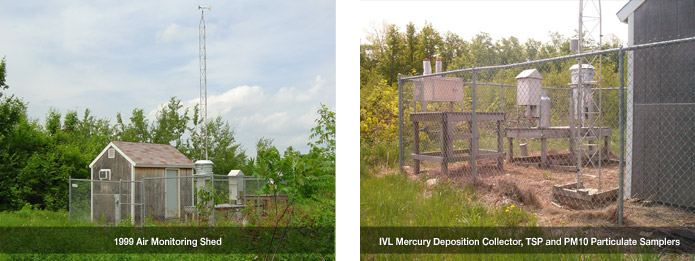
Sulfur Dioxide (SO2)
Description
Sulfuric particles in the air that dissolve in water to form acid.
Sources
Coal-fired power plants, refineries.
Health Effects
Eye irritation, wheezing, chest tightness, lung damage.
Welfare Effects
Contributes to formation of acid rain, promotes methylation of mercury (toxic form); see mercury deposition and acid deposition.
Ozone (O3)
Description
Harmful gas at lower levels of the atmosphere.
Sources
Coal-fired power plants, motor vehicles, industry.
Health Effects
Irritation to lung and respiratory system.
Welfare Effects
Limits growth and production of some plants, and causes ulcers on leaves. Causes the same health effects to animals as humans. Is an element of smog, limiting visibility.
Particulates (PM 2.5)
Description
Very small particles of soot, dust, or other matter.
Sources
Diesel engines, power plants, wood stoves.
Health Effects
Eye irritation, asthma, lung damage, cancer. Fine particulates have also been associated with heart disease and diabetes as it is absorbed into the blood stream by capillaries in the lungs.
Welfare Effects
Limits the extent of visibility, adversely affects ecosystem processes, damages buildings/structures, and affects climate.
Oxides of Nitrogen (NO, NO2, NOx)
Description
Brown color associated with smog. A component in the formation of ozone and smog.
Sources
Motor vehicles, off-road equipment, generation of electricity, other fossil fuel combustion.
Health Effects
Irritation to lung and respiratory system.Irritant to individuals w/heart disease.
Welfare Effects
Releases aluminum from soils that run into water bodies, making the environment toxic to fish. Causes depletion of oxygen in water. Increases ozone levels and limits visibility. See acid deposition.
Acid Deposition
Description
Both wet (precipitation) and dry particles in the air containing high levels of sulfuric and nitric acid.
Sources
Coal-fired power plants, burning of fossil fuels such as in motor vehicles and diesel generators/boilers.
Health Effects
The harm from acid rain is not direct. However, the pollutants that cause acid rain—sulfur dioxide (SO2) and nitrogen oxides (NOx)—do contribute to heart and lung disorders like asthma.
Welfare Effects
Changes chemical and physical characteristics of water and soil resulting in a loss of biodiversity. Affects the physical development of organisms and stresses trees/plants. Converts mercury deposited in the water to its toxic form. See mercury below.
Mercury Deposition and Vaporous Mercury
Description
Particles and/or a colorless, odorless vapor in the air. Falls to the earth and into water bodies and is converted to a form that is taken up by bacteria and works its way up the food chain into fish that we eat. As a vapor, it diffuses through the alveoli in the lungs and is ionized by the blood then deposited in the central nervous system.
Sources
Coal-fired power plants, smelters, factories, medical and municipal waste incinerators, mining activities.
Health Effects
Causes neurological and developmental damage, memory loss, liver and kidney and brain damage. Effects motor coordination skills. Especially harmful to developing fetuses and young children.
Welfare Effects
Is taken up by aquatic organisms that are then taken eaten by fish. It accumulates in fish making them toxic to eat. Has similar affects on wildlife that consume fish as it does on humans.
Lead (Pb)
Description
Metal particles in the air and in the soil, regulated by EPA under the air toxics program.
Sources
Industry, metal processing – waste incinerators, utilities, and lead-acid battery manufacturers, lead contaminated residential soil.
Health Effects
Reproductive problems, high blood pressure, hypertension, nerve disorders, memory and concentration problems, muscle and joint pain, damage to brain and nervous system, behavior and learning problems, hearing problems, headaches.
Welfare Effects
Harms plants and affects wildlife similarly to humans, accumulates in soils, and adversely impacts both terrestrial and aquatic systems.
